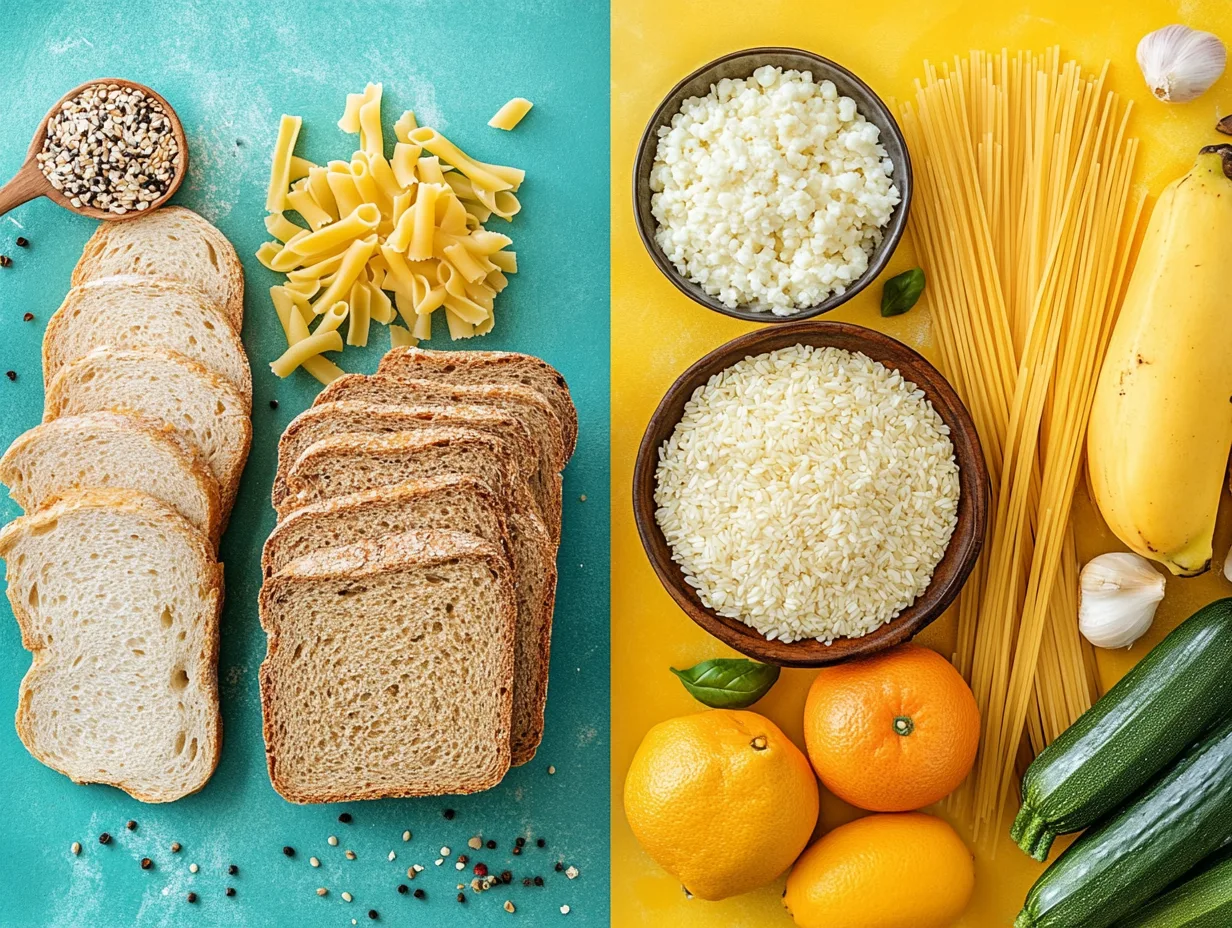Diabetes management hinges on making informed food choices that help control blood sugar levels while still satisfying your taste buds. One effective approach is incorporating smart carbohydrate swaps into your daily routine. By replacing high-glycemic carbs with nutrient-rich, lower-glycemic alternatives, you can enjoy a wider variety of foods without compromising your blood sugar control. This guide explains the science behind carb swaps, outlines their benefits, and provides practical tips and recipe ideas to help you transition to a diabetes-friendly diet.
Understanding Carb Swaps and Their Role in Diabetes Management
Not all carbohydrates affect blood sugar equally. The glycemic index (GI) measures how quickly a food raises blood glucose, and foods with a high GI can cause rapid spikes. For people with diabetes, these spikes can lead to long-term health issues. Smart carb swaps focus on substituting high-GI foods with whole, fiber-rich alternatives that provide a slower, more steady release of glucose into the bloodstream. For example, switching from white rice to quinoa or from white bread to whole-grain bread can help maintain stable energy levels.
For more detailed insights on carbohydrate quality and its impact on diabetes, check out resources like the American Diabetes Association and Mayo Clinic.
The Benefits of Making Smart Carb Swaps
Integrating smart carb swaps into your diet offers several advantages for diabetes management:
- Stabilized Blood Sugar: Lower-glycemic foods help prevent sudden blood sugar spikes.
- Improved Satiety: High-fiber alternatives keep you feeling full longer, reducing overeating.
- Enhanced Nutritional Value: Whole grains, legumes, and vegetables are rich in vitamins, minerals, and antioxidants.
- Weight Management: Swapping processed carbs for nutrient-dense options supports a healthy weight.
- Heart Health: Many low-GI foods also contribute to improved cardiovascular health.
Top Smart Carb Swaps to Transform Your Diet
Here are some effective carb swaps that can make your meals both delicious and diabetes-friendly:
1. Replace White Rice with Whole Grains
- Why: White rice is highly processed and causes rapid glucose spikes.
- Smart Swap: Choose brown rice, quinoa, barley, or farro for added fiber and nutrients.
- How: Use whole grains in stir-fries, salads, or as a side dish.
2. Swap White Bread for Whole Grain or Sprouted Bread
- Why: White bread lacks the fiber and nutrients found in whole-grain alternatives.
- Smart Swap: Opt for whole wheat, oat, or sprouted grain breads (like Ezekiel bread).
- How: Enjoy these breads in sandwiches, toast, or as a base for healthy snacks.
3. Choose Whole Wheat or Legume-Based Pasta Over Regular Pasta
- Why: Traditional pasta is refined and can spike blood sugar.
- Smart Swap: Use whole wheat pasta or pasta made from chickpeas or lentils.
- How: Prepare your favorite pasta dishes with these alternatives to boost fiber and protein.
4. Swap Regular Potatoes for Sweet Potatoes or Cauliflower Rice
- Why: Regular potatoes have a high GI and may cause rapid sugar increases.
- Smart Swap: Replace them with sweet potatoes or try cauliflower rice as a low-carb substitute.
- How: Roast sweet potatoes or use cauliflower rice in place of white rice.
5. Opt for Fruit-Based Snacks Instead of Sugary Processed Options
- Why: Processed snacks with added sugars can destabilize blood sugar levels.
- Smart Swap: Enjoy fresh fruits paired with a protein source, such as Greek yogurt or a handful of nuts.
- How: Swap candy or cookies for a serving of berries or an apple with nut butter.
Incorporating Smart Carb Swaps into Your Daily Routine
Transitioning to a diabetes-friendly diet with smart carb swaps can be simple with a few practical strategies:
Meal Planning and Preparation
- Plan Your Meals: Create weekly menus that include whole grains, legumes, and non-starchy vegetables.
- Batch Cooking: Prepare staples like quinoa, brown rice, or roasted sweet potatoes in advance for quick meal assembly.
- Smart Shopping: Build a grocery list centered on whole foods and minimally processed ingredients.
Cooking Techniques and Tips
- Experiment with Flavors: Enhance meals with herbs, spices, and healthy fats without relying on extra sugars.
- Try Modern Tools: Use air fryers or other innovative kitchen gadgets to prepare healthier versions of your favorite dishes.
- Practice Mindful Eating: Take your time with each meal to better recognize hunger cues and avoid overeating.
Sample Meal Ideas
Quinoa and Veggie Bowl
Ingredients:
- 1 cup cooked quinoa (swap for white rice)
- 1 cup steamed broccoli
- 1 cup roasted Brussels sprouts
- 1/2 cup cherry tomatoes, halved
- A drizzle of olive oil and lemon juice
- Salt and pepper to taste
Instructions:
- Mix all ingredients in a large bowl.
- Drizzle with olive oil and lemon juice, season with salt and pepper, and toss gently.
- Enjoy as a nutritious lunch or dinner.
Cauliflower Rice Stir-Fry
Ingredients:
- 1 head cauliflower, processed into rice-sized pieces
- 1 cup mixed non-starchy vegetables (e.g., bell peppers, snap peas, carrots)
- 1/2 cup lean protein (chicken or tofu, cubed)
- 2 cloves garlic, minced
- 1 tablespoon low-sodium soy sauce or tamari
- 1 teaspoon sesame oil
- Garnish with green onions and sesame seeds
Instructions:
- Heat sesame oil in a pan and sauté garlic until fragrant.
- Add lean protein and cook until lightly browned.
- Stir in the vegetables and cook for about 5 minutes.
- Add cauliflower rice and soy sauce, cooking for another 5 minutes.
- Garnish with green onions and sesame seeds before serving.
Expert Nutritional Insights on Carb Management
Nutrition experts agree that focusing on carbohydrate quality is key to managing diabetes. Replacing high-GI foods with whole, unprocessed alternatives not only stabilizes blood sugar but also improves overall health. For example, research available through Harvard Health Publishing emphasizes the benefits of dietary fiber and whole grains in reducing diabetes risk and managing blood sugar levels.
Making Smart Carb Swaps Sustainable
Transitioning to smarter carb choices is a gradual process. Here are some tips to help make these changes stick:
- Start Small: Introduce one or two swaps per week and build on your successes.
- Keep a Food Journal: Track your meals and blood sugar responses to see what works best for you.
- Educate Yourself: Stay informed about the glycemic index and nutrient benefits of whole foods.
- Stay Organized: Batch cook and prepare your ingredients ahead of time to ensure you have healthy options available.
- Experiment: Don’t be afraid to try new recipes and ingredients to keep your diet exciting and diverse.
Final Thoughts
Smart carb swaps are a powerful tool in diabetes management. By replacing high-glycemic foods with whole, nutrient-dense alternatives, you can achieve more stable blood sugar levels, improved satiety, and better overall health. Start small, stay informed, and be patient with the process—each smart swap brings you closer to a balanced, diabetes-friendly diet.
For more creative diabetes-friendly recipes that incorporate smart carb swaps and modern cooking techniques, consider exploring the Diabetic Air Fryer Cookbook.


Leave a Reply